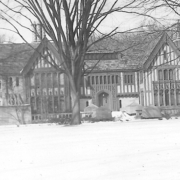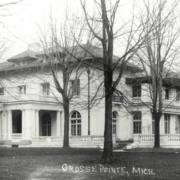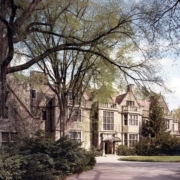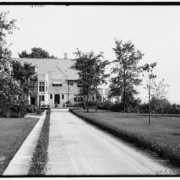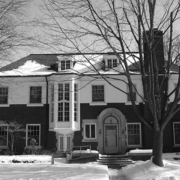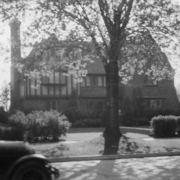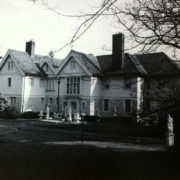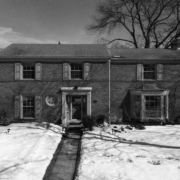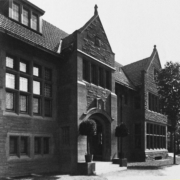Historical Architecture of Grosse Pointe – 22 Webber Place
Last week we previewed 938 Balfour, completed in 1922, as a speculative home by the talented Leonard B. Willeke.
This week we stay with the work of Leonard Willeke to feature one of his most prominent projects, 22 Webber Place. The grand estate was completed in 1927, for Oscar Webber, General Manager of Hudson’s Department Store, and the nephew of Joseph L. Hudson. (Joseph Hudson emigrated from Ontario to Michigan – in 1881, he opened a small men’s and boy’s store in Detroit. Before his death in 1912, the once small shop had grown to be the largest department store in the city). Oscar Webber was born in Ionia Township in 1889. Oscar, along with his three brothers, ran the Hudson Department Store for several decades. He was married to Marjorie Lambert. Prior to moving to Webber Place the couple resided at 1014 Bishop since 1921.
The original address of 22 Webber Place, Oscar and Marjorie’s new home, was 619 Lake Shore Rd. It was the largest residential commission of architect Leonard B. Willeke’s distinguished career. It is reported Oscar Webber began planning a house with Willeke in 1921. The property was originally going to be built at the foot of Whittier, however Webber decided against the location and purchased land on Lake Shore Road. In 1923, Willeke drew numerous plans for a magnificent Tudor home. A design was finally selected in the summer of 1925, and ground was broken – it is reported the property would cost around $179,000 (around $2.8m today). It is also reported Webber retained complete control of the final design, with much redrawing and additional costs (accrued by Webber), before the final plans were approved. It is said the relationship between Webber and Willeke was strained at times, however both men had a mutual respect for each other and tolerated the frustrations during the ten-year span of the project. Source: Leonard B. Willeke, Excellence in Architecture and Design by Thomas Brunk.
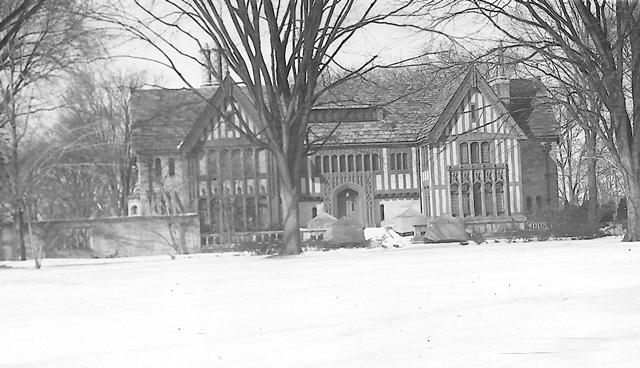
Based on the book by Thomas Brunk, we understand during the summer of 1927, Oscar Webber, his wife Marjorie, their daughter, his father-in-law and staff moved into the 10,304 sq ft mansion. Upon completion it had cost the Webber family a reported $476,079 (around $7.3 today) to build and was beyond opulent. At the time, Willeke wrote “the best opportunity I have had in Detroit to do something fine, of which you and Mrs. Webber, as well as myself, could be justly proud”. Image of the house courtesy of: digital.library.wayne.edu – Virtual Motor City Collection, 1951.

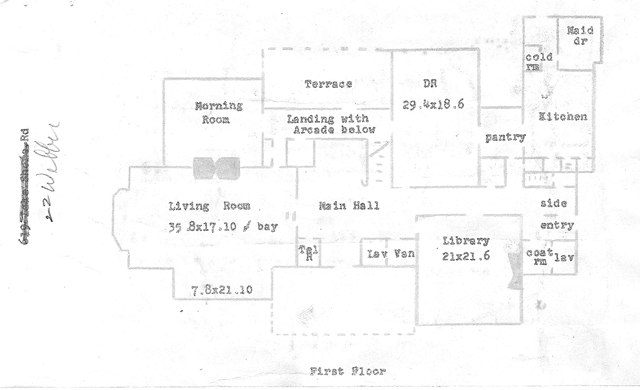

The three-story, seven-bedroom, Tudor property was (and still is) truly stunning. The exterior has an abundance of leaded cathedral windows’ that are well balanced and constructed from a number of materials – brick, stone, plaster and timber. Brunk (in the book) worte – ‘Willeke selected the colors carefully with regard to the quality of light and shadows at various times of the day. The slate roof, its thickness and color, enhances the design of the home, with the crowning feature, the stylish terracotta chimney pots’. Image courtesy of Google.com
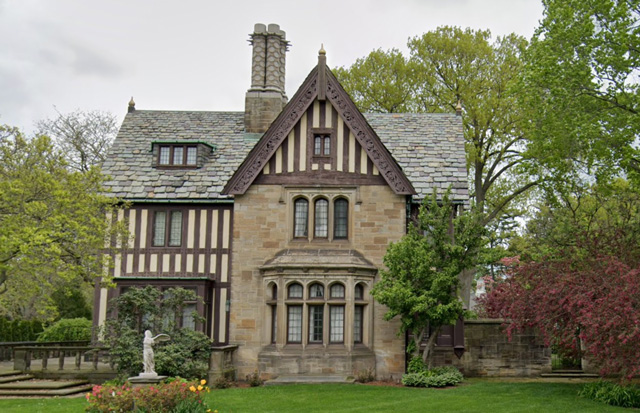
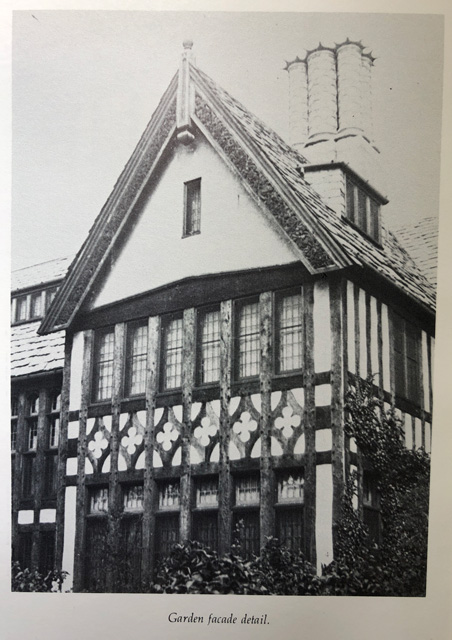
The remarkable detailing on the exterior is continued throughout the interior on the doors, main staircase, and fireplaces – featuring birds, vines, flowers and grapes. Wood, in general, was a huge feature in several rooms throughout the home, including both chestnut and oak paneled walls. The six fireplaces have elaborate hand carved details and include stunning Pewabic tile (Mary Chase Stratton, the Pewabic pottery’s co-founder, worked closely with Willeke to create special colors and beautiful surface effects). Tile was also the main feature of the properties eleven bathrooms – the rooms were tiled exclusively with handmade Pewabic tile in varying colors. Source: Thomas Brunk. Historic photos of the interior courtesy of: Leonard B. Willeke, Excellence in Architecture and Design by Thomas Brunk.
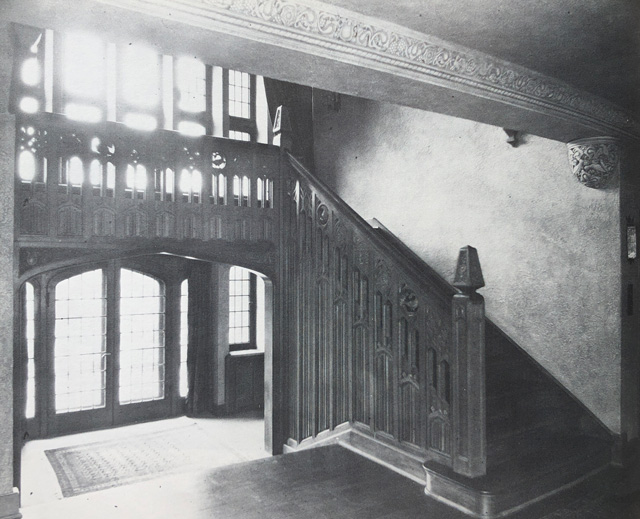
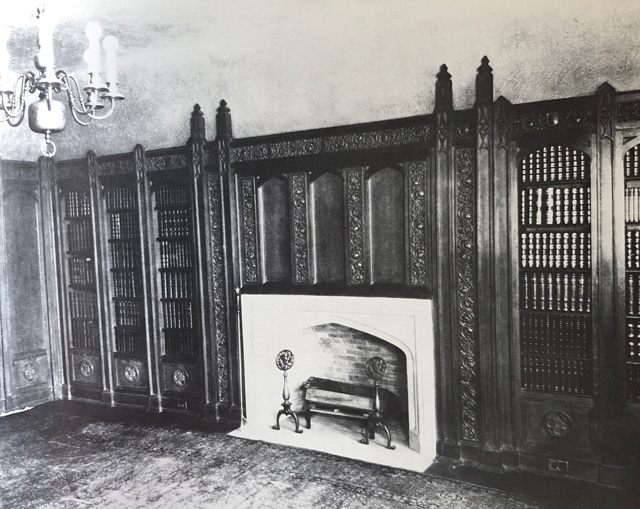
As part of the commission Willeke also wanted to retain control of the landscape design, yet despite his talent in this field Webber hired nationally renowned designer, Ellen Biddle Shipman to create the garden. The complex design had varying levels, with alternating informal and formal borders that were connected by flagstone paths. The final design included a cedar arch, rock garden, a children’s play lawn, a formal rose garden, along with a tea house and swimming pool. At the rear of the property was the carriage house with an attached green house, a vegetable garden, and an orchard. Historic photo courtesy of: Leonard B. Willeke, Excellence in Architecture and Design by Thomas Brunk.

In Brunk’s book he writes, in 1930, Webber had Willeke design an addition to the kitchen (at a cost of a $17,000 – around $270,000 today) and changed the interior design of the sunroom that included structural changes. It is also reported that Webber also asked Willeke to devise a plan for the eventual subdivision of the estate – given the depth of the property – that would preserve the character and ambience of the home. The solution proposed by Willeke (in 1924) allowed for the construction of six additional houses on the property. We can report, from our files that, in 1964, the then owner of the property (C. Jankowski) listed the home for sale (in June 1964) and ‘had plans to demolish the house in three weeks if the property was not sold. There would then be a total of 10 lots in the parcel to build on’. Thankfully the property sold a couple of weeks later, and the property was spared, however, part of the estate was subdivided later that year – Willeke’s original plan (created in 1924) for the sub-division was not followed.
Oscar Webber resided at 22 Webber Place until 1946. Following the death of his wife, Marjorie, in 1941, and the marriage of his daughter, Webber found the house too large and moved to a smaller home on Beacon Hill Road until he passed in 1967.
Today 22 Webber Place still maintains the charm and many of the original characteristics that Oscar Webber and Leonard Willeke had envisioned for this very special home.
*Photos courtesy of the Higbie Maxon Agney archives unless stated.
Written by Katie Doelle
Copyright © 2021 Katie Doelle

